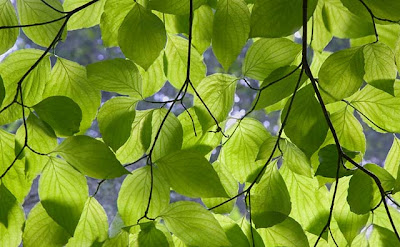Image of dogwood leaves courtesy Henry Domke Fine Art
I met several members of the American Society of Hypertension yesterday, and they were intrigued by the idea of nature as an antidote to stress and, specifically, hypertension. As someone who works in this field every day, I forget that there are lots of people who don’t make the connection, other than intuitively (“well sure, every time I work in the garden, I feel better!”), that interaction with nature facilitates good health.
For example, these ASH members were surprised to learn that clinical studies have shown, on a quantitative rather than simply qualitative level, that gardens and other natural landscapes lower blood pressure and heart rate, speed up recovery in hospital patients, increase people’s ability to concentrate and recover from stressful situations, and generally increase people’s sense of well-being. Many of those positive benefits have to do with lowering stress. And guess what one of the leading causes of hypertension is? You guessed it: Stress! Therefore, it stands to reason that interaction with nature could be an excellent prescription for hypertension and so many of its associated illnesses.
Hypertension is the clinical word for high blood pressure; it is a medical condition in which blood pressure is chronically elevated. It is one of the leading risk factors for a slew of other serious health problems, including strokes, heart attacks and other heart failure, arterial aneurisms, and renal failure.
So just as stress sets up a chain reaction that adversely affects our health, interaction with gardens and other landscapes initiates a positive chain reaction that can ameliorate stress and its domino effect. If that’s too simplistic, you can refer to some of the research below for more detailed explanations. And if you have references that aren’t below or on the Therapeutic Landscapes Database’s References page, we’d love your input. And as always, your comments are welcome.
In Sweden, gardens and horticultural therapy are being used clinically to treat patients with stress-related illnesses such as burnout and chronic fatigue syndrome. Here are two articles about these programs:
Clare Cooper Marcus, “Gardens as Treatment Milieu: Two Swedish Gardens Counteract the Effects of Stress.” Landscape Architecture Magazine, Vol. 96, No. 5, May 2006.
Patrick Millet, “Integrating Horticulture into the Vocational Rehabilitation Process of Individuals with Fatigue, Chronic Fatigue, and Burnout: A Theoretical Model.” Journal of Therapeutic Horticulture, Vol. 19, 2009, pp. 10-22.
In almost every article and presentation on the benefits of nature, Roger S. Ulrich refers to reduction of stress. Here are just a couple of examples:
Roger S. Ulrich, R. F. Simmons, B. D. Losito, E. Fiorito, M. A. Miles, and M. Zelson, “Stress Recovery During Exposure to Natural Urban Environments.” Journal of Environmental Psychology, Vol. 11, 1191, pp. 201-230.
In a blog post from a while back (“How the City Hurts Your Brain – and what you can do about it”), I discussed Stephen and Rachel Kaplans’ Attention Restoration Theory (ART), which is one explanation about how interaction with nature reduces stress. Here’s a good article about that: “The Cognitive Benefits of Interacting With Nature,” by Mark G. Berman, John Jonides, and Stephen Kaplan in Psychological Science, Vol. 19, No. 12, pp. 1207-1212.
